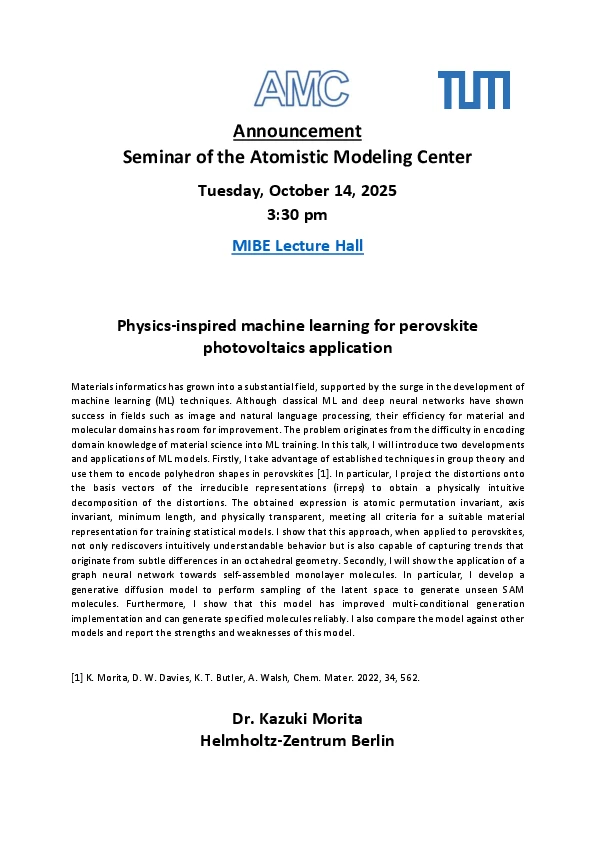The AMC Seminar is back! After the summer break, the Winter Term Seminar Series on Atomistic Modeling-related topics will start next Tuesday.
Kicking off our Winter Term Seminar Series, we’re excited to welcome Dr. Kazuki Morita as our first speaker. Morita joined the group of Prof. Antonio Abate at Helmholtz-Zentrum Berlin as Humboldt Fellow in May 2024. His research focuses on the stability of tin halide perovskites by investigating the tin oxidation process using theory and simulations.
Materials informatics is advancing with machine learning, though challenges remain in encoding domain-specific knowledge. In his talk on “Physics-inspired machine learning for perovskite photovoltaics application”, Morita will introduce a group theory-based method for representing perovskite distortions and a generative diffusion model for designing self-assembled monolayer molecules. Both approaches improve physical interpretability and generative accuracy, offering promising tools for materials discovery.
Date: Tuesday, October 14, 2025, 3:30 pm
Location: MIBE Lecture Hall
Abstract:
Materials informatics has grown into a substantial field, supported by the surge in the development of machine learning (ML) techniques. Although classical ML and deep neural networks have shown success in fields such as image and natural language processing, their efficiency for material and molecular domains has room for improvement. The problem originates from the difficulty in encoding domain knowledge of material science into ML training. In this talk, I will introduce two developments and applications of ML models. Firstly, I take advantage of established techniques in group theory and use them to encode polyhedron shapes in perovskites [1]. In particular, I project the distortions onto the basis vectors of the irreducible representations (irreps) to obtain a physically intuitive decomposition of the distortions. The obtained expression is atomic permutation invariant, axis invariant, minimum length, and physically transparent, meeting all criteria for a suitable material representation for training statistical models. I show that this approach, when applied to perovskites, not only rediscovers intuitively understandable behavior but is also capable of capturing trends that originate from subtle differences in an octahedral geometry. Secondly, I will show the application of a graph neural network towards self-assembled monolayer molecules. In particular, I develop a generative diffusion model to perform sampling of the latent space to generate unseen SAM molecules. Furthermore, I show that this model has improved multi-conditional generation implementation and can generate specified molecules reliably. I also compare the model against other models and report the strengths and weaknesses of this model.
[1] K. Morita, D. W. Davies, K. T. Butler, A. Walsh, Chem. Mater. 2022, 34, 562.
